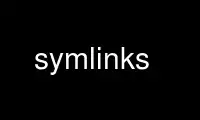
This is the command symlinks that can be run in the OnWorks free hosting provider using one of our multiple free online workstations such as Ubuntu Online, Fedora Online, Windows online emulator or MAC OS online emulator
PROGRAM:
NAME
symlinks - symbolic link maintenance utility
SYNOPSIS
symlinks [ -cdorstv ] dirlist
DESCRIPTION
symlinks is a useful utility for maintainers of FTP sites, CDROMs, and Linux software
distributions. It scans directories for symbolic links and lists them on stdout, often
revealing flaws in the filesystem tree.
Each link is output with a classification of relative, absolute, dangling, messy, lengthy,
or other_fs.
relative links are those expressed as paths relative to the directory in which the links
reside, usually independent of the mount point of the filesystem.
absolute links are those given as an absolute path from the root directory as indicated by
a leading slash (/).
dangling links are those for which the target of the link does not currently exist. This
commonly occurs for absolute links when a filesystem is mounted at other than its
customary mount point (such as when the normal root filesystem is mounted at /mnt after
booting from alternative media).
messy links are links which contain unnecessary slashes or dots in the path. These are
cleaned up as well when -c is specified.
lengthy links are links which use "../" more than necessary in the path (eg. /bin/vi ->
../bin/vim) These are only detected when -s is specified, and are only cleaned up when -c
is also specified.
other_fs are those links whose target currently resides on a different filesystem from
where symlinks was run (most useful with -r ).
OPTIONS
-c convert absolute links (within the same filesystem) to relative links. This
permits links to maintain their validity regardless of the mount point used for the
filesystem -- a desirable setup in most cases. This option also causes any messy
links to be cleaned up, and, if -s was also specified, then lengthy links are also
shortened. Links affected by -c are prefixed with changed in the output.
-d causes dangling links to be removed.
-o fix links on other filesystems encountered while recursing. Normally, other
filesystems encountered are not modified by symlinks.
-r recursively operate on subdirectories within the same filesystem.
-s causes lengthy links to be detected.
-t is used to test for what symlinks would do if -c were specified, but without really
changing anything.
-v show all symbolic links. By default, relative links are not shown unless -v is
specified.
Use symlinks online using onworks.net services
